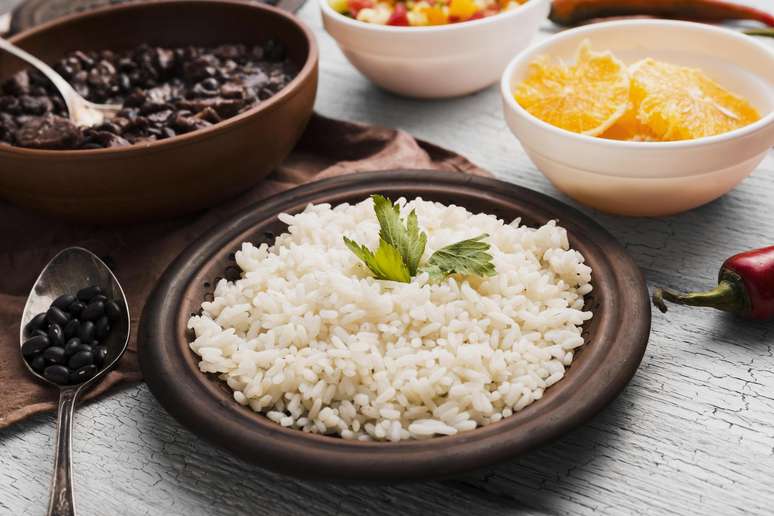Find out what to include in food to be able to improve or prevent inflammation in the body
After all, what is an anti -inflammatory diet? It is a food re -education that aims to reduce chronic inflammation, related to cardiovascular diseases, hypertension, anxiety, depression, type 2 diabetes, some types of cancer, depression and obesity.
It is not a specific regime, but a feeding style. That is, in its essence, this diet follows the Mediterranean style, focusing on healthy fats (olive oil, nuts, almonds, avocado and fish), foods rich in nutrients (fruit, vegetables and vegetables), low -blood sugar carbohydrates (whole grains), fresh herbs and spices.
But it is also necessary to take some foods that are not part of the menu. Such as, for example, soda and sweetened juices, refined carbohydrates (bread and white pasta), desserts (biscuits, sweets, cakes and ice cream), transformed meats (turkey breast, mortadella and sausages), transformed snacks (biscuits and palized sausages) and alcohol.
Therefore, according to the nutritionist Adriana Stavro, to reduce or prevent inflammation, it is important to maintain a diet based on foods rich in nutrients and antioxidants. “The anti-inflammatory diet should provide a healthy balance of proteins, carbohydrates, fats, vitamins, minerals and fibers, giving priority to food with anti-inflammatory properties,” he explains.
13 foods that cannot be missing in the anti -inflammatory diet
1. Purple grapes
The grapes have resveratrol, a vegetable compound with anti -inflammatory and antioxidant properties. In addition, they can reduce the risk of heart disease, diabetes, obesity, diseases of Alzheimer’s and eyes.
2. Red fruits
Red fruits such as blueberries, strawberries, raspberries or more contain different essential micronutrients such as fiber, polyphenols and antioxidants (anthocyanins), composed with the action in the fight against inflammation. Not only do they reduce existing inflammation, but also prepare cells to respond better to any future inflammation.
3. Broccoli
Broccoli and other cruciferous vegetables, such as Cauliflower and Cavolflowe of Bruxlela are rich in Vit K, C, Potassium, Magnesium, Fiber and Sulforaphane. Therefore, according to the nutritionist, the potential protective role of the cruciferous vegetables and the active components present in these plants has been widely studied. And the results have shown that this plant class can even delay the development of cancer.
4. Omega-3
Salmon and other fatty fish are rich in omega-3 fatty acids (W3). According to Stavro, the W3 anti -inflammatory properties have been described for their role in the prevention and treatment of conditions such as coronary heart disease, diabetes, inflammatory intestinal, Alzheimer’s, bipolar disorder, schizophrenia and cystic fibrosis. W3 is also beneficial for autoimmune diseases such as lupus, rheumatoid arthritis, type 1 diabetes, ulcerative colitis, psoriasis and multiple sclerosis.
Vary the menu is important not to get sick
5.
Turmeric, a long turmeric rhizome, is a tasty yellow-orange spice. The components of the curuma are called curcuminoids. And the most important thing is Curcumin. According to the expert, it has been used in alternative medicine for centuries, as it is not toxic and has a variety of therapeutic properties, including anti -inflammatory, antioxidant, antimicrobial, liver, immunostimulating, antiseptic, analgesic and antique.
6. Pumpkin seeds
Pumpkin seeds contain polyunsaturated fatty acids, potassium, vitamin B2 (riboflavin), folate, vitamin and carotenoids, which are antioxidants, vitamins and minerals essential for the immune system. They are delicious as snacks, but they can also be sprinkled with salads or soups above.
7. Green leaves
Spinach, cabbage causes of death all over the world.
8. Avocado
Avocado are sources of healthy (monounsaturated) fats that help reduce the inflammation of cholesterol and joints. Avocado also contain vitamin K, C and E, manganese, selenium and zinc. The various fruit nutrients were also beneficial in the prevention of neurodegenerative diseases such as Alzheimer and Parkinson’s.
Every detail has its importance
9. Green tea
Green tea is rich in catechins. According to Stavro, research suggests that catechins are composed of anti -inflammatory that prevent the formation of free radicals, inhibit the formation of cancer cells, promote the growth of beneficial bacteria in the intestine and reduce the risk of Alzheimer’s.
10. Tomatori
Tomatoes are a source of lycopene. The lycopene is the pigment that gives color to red and pink fruits such as tomatoes, watermelon and strawberry. It is a nourishing with antioxidant properties associated with the health benefits of the heart and protection against solar burns and some tumors.
11. Full grains
These grains contain more fiber, proteins, selenium, potassium and magnesium than refined cereals. They also have a lower glycemic index that minimizes the inflammatory effects that is observed with extreme fluctuations and constant glucose. In addition, a diet rich in grains was associated with better weight control.
12. Olive oil oil
According to the nutritionist, olive oil contains about 36 phenolic compounds and it is this phenolic fraction that is responsible for anti -inflammatory, antioxidant and antimicrobial benefits. The main anti -inflammatory effects of olive oil are mediated by antioxidants. The highlight is “oleocanthal, which has shown to act similarly to hybuprofen, an anti -inflammatory drug”, says Stavro.
Over
13. Chia
Chia seeds are known as a superfood. They all offer nine essential amino acids and are therefore a high quality plant protein. Over 80% of the seed carbohydrate content is in the form of fiber. Fiber is mainly soluble, responsible for the sticky consistency of moistened seeds.
This fiber can be fermented in the intestine, promoting the formation of short chain fatty acids (AGCC) and improving colon health. Another important feature of Chia is its high omega-3 content. In fact, the chia is the best known vegetable source of W-3, even better than flax seeds.
The most exceptional minerals are: manganese, essential for metabolism, growth and development; phosphorus, which contributes to the health of the bones and the maintenance of the fabrics; Copper, important for heart health; Selenium, an important antioxidant and calcium, essential for bones, muscles and nerves.
Source: Adriana Stavro, a nutritionist master at the University Center of San Camilo.
Source: Terra
Ben Stock is a lifestyle journalist and author at Gossipify. He writes about topics such as health, wellness, travel, food and home decor. He provides practical advice and inspiration to improve well-being, keeps readers up to date with latest lifestyle news and trends, known for his engaging writing style, in-depth analysis and unique perspectives.






![A Better Life Preview: What’s in store for Tuesday, November 4, 2025 Episode 456 [SPOILERS] A Better Life Preview: What’s in store for Tuesday, November 4, 2025 Episode 456 [SPOILERS]](https://fr.web.img2.acsta.net/img/e0/d0/e0d004677b72ee91fa84c48063af3e15.jpg)

